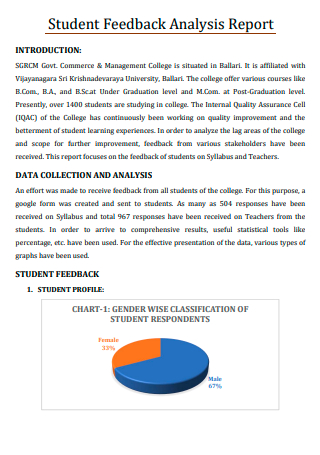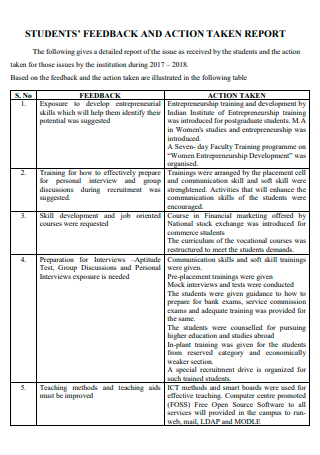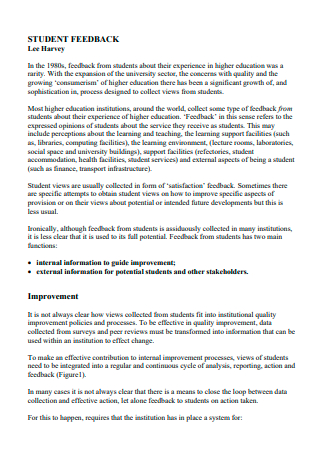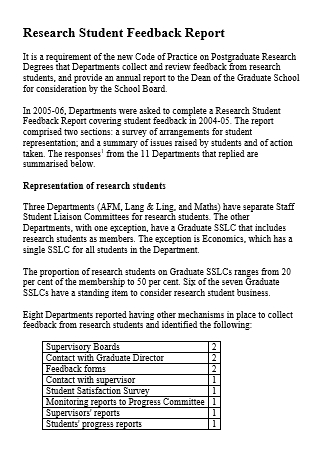3+ SAMPLE Feedback Report For Students
In this article, you will learn some things about feedback report for students. You will have tips that you can use on how to do a feedback report. Types of feedback will be discussed. You will also learn how to write feedback for students. Are you curious about these things? Then, be relaxed and keep on reading!
What is a Feedback Report For Students
The feedback report for students are comments that can be found on a report card or on feedback form for students. These are the observations about the performance of a student. The student may be a student in a training, workshop, event, group, organization, or couse. Aside from the actual grades of the students, the feedback is given through a report. It is done so that students will have a complete report about his or her abilities. The students will know how they are actually doing in school or in training. Feedback is crucial because students can change according to the report that they can get. They can strive if they are lacking. They can further excel if they are doing good. Feedback will be a good influence for the achievement of every student. It can synchronise learning and it can make it visible. It is a key element in the process of assessing the actual capability of students. Practitioners, peers, and the students themselves can improve learning by giving information about the performance. In this way, learning can advance and evaluation can make it better. Every student will have something to rely on so that they can improve their skills.
Types of Feedback
Feedback comes in different forms. But whatever is the type of feedback, what matters is its quality. Will it give improvement to the students? How helpful will it be? To give a better feedback, you should know its different kinds. You may use the one that will be best for the learning that you are teaching. Here are its different types:
Oral Feedback
Oral feedback is the feedback that it is given verbally. It is commonly given during every class. The oral feedback may be a little informal but we must not underestimate it. It is timely and is an effective tool that is instilled while the teacher is on the moment of teaching you. It can be more memorable and the teacher can insert a personal approach in giving the feedback. Its advantage also is that the teacher can see the reaction of the students, so they can adjust the feedback according to the acceptance of the students. It can be a good way on how the students and the teachers can be in harmony in promoting the advancement of learning.
Written Feedback
A written feedback is usually given after a task. It will give a record of the things that the students have been doing well. It will tell the improvement that a student will need to do and it can nurture a student of the next steps that they can do. It has the information on how the student has met the success criteria in learning. Most times, a written feedback is better not only because it is a formal way of giving a feedback but because the students will not have the chance of being ashamed because of the feedback. The feedback will just be sent to the student and will just be read.
Evaluative Feedback
Evaluative feedback is usually in the form of giving grades or giving short comments like ‘well done’. You may not have the chance of saying a more elaborate feedback, but you will give a rightful performance evaluation. The comments will be brief so you have to include your whole evaluation with this short comment. Information can be given through an evaluative feedback but the students will not have something to use for improvement. Usually, this feedback involves a comment of praise which can make the students proud of their work. Research suggests that the praise should be true, or else the feedback will be meaningless.
Descriptive Feedback
Descriptive feedback is a detailed specification of feedback. The teachers will have to give a more detailed description of comments about the learning achievement of every student. Information should be specific so the students will know how to improve their learning. The ‘next steps’ that the students will do will be given more definitely so that the students will have the capability of self-correcting. They can also have a better self-assessment that can help them to strive further if they can see that they lack understanding about the course that they have been studying. If you want to use a descriptive feedback, you can search for examples of descriptive feedback for students on the internet.
Informal Feedback
Informal feedback is given when a teacher facilitate the discussion and impromptu questions are given. Answering these questions is providing an informal feedback. This feedback is usually not planned and can be given only as the situation needs for it.
Formal Feedback
Like written feedback, the formal feedback is provided at the end of every tasks. It has definite goals and it is given through structured conferences. There is a system in giving a formal feedback. It is usually planned and the process is scheduled. It consists of marking criteria and accomplishment of standards. It is always recorded and can be a source of evidence.
Peer Feedback
Peer feedback happens when other students offer to give advice on the student’s work. It can be possible through peer conferences. It can give a positive aspect on the understanding of learning. Peers can give comments on how a student has been doing with the learning intentions and how they can get improvement. Because the peers can criticize the student’s work, the teacher should lead them on how they can give feedback in a good way.
Self-feedback
Self-feedback is something that every students should learn. They should have the skills on how they can assess their works. They can be more independent in having self-assessment. They can also learn to set goals for themselves that they can be capable of achieving.
Tips on Feedback Report For Students
Filling up a feedback form for students means that you are concerned for the learning of the students. You are not criticizing them, but you will give good measures on how they can improve in their studies. As you are thinking of the welfare of the students, you must ensure that they can get the right comments for improvement. You can use some tips so you can make your feedback better. Apply the following tips for your feedback for students’ performance:
How to Write a Feedback Report For Students
Do you already know how to give feedback to students? Do you know how to write feedback report for students? Well, consider the following steps so you can write a feedback report to students:
Step 1: Make a record of the students’ performance.
You might want to have a better evaluation of the performance of your students. You can do this if you will keep track of the students’ progress. Make a schedule where you can write the points on the performance of your students. Have a notebook where you can list the points that you can use to give them a proper feedback. Record everything that you can observe from them.
Step 2: Make an affirmation.
The best way to give a feedback is to give some praise to the students’ achievements. Whenever you should give an affirmation, do not forget to put it in your feedback. Providing a positive feedback can be a good format in any feedback report. You can be assured that students can get enthusiasm with everything that you said and they will strive further with their works.
Step 3: Do some correction.
You can provide correction in your feedback report. Just remember to do it constructively. Negative feedback can make students sad, and can lose their interest in the course. So, if you have something to say to correct them, do it in a good manner. You must also guide them on how they can correct their works. Give examples and definite instructions that can show them the way.
Step 4: End with an action plan.
At the end of your feedback, you can provide an action plan that the students can do. With this, they can improve with their studies and they can be sure that they can attain all the goals of learning. You can advice for the best learning style or you can just simply tell them what to do in the aspects where they are lacking. Even if the students excel, you should give them some action points so they can further excel with their studies.
FAQs
Why is Feedback Important?
Feedback can give focus to the students. They will learn how they can give their efforts to their best so that they will achieve success in their learning. It also enhances their performances. The quality of their works are increased and they can meet the standards of learning achievement. They can also have a good motivation. It can assure them that they are doing fine with their works or if ever they are not doing well, they can have something to correct them.
Who Provides the Feedback?
Usually, the teacher provides the feedback. Sometimes, it can be given by mentors. Or peers. They give feedback to provide support to students and some advice on how they can advance with their works. Usually, feedback is given from the persons who saw the performance of the students.
If you are a student, you must be receptive on feedbacks. It can help you to be a better student and it can make you improve in all your tasks. Students can excel by handling feedbacks well. Do not take it for granted. It is given for the advancement of your learning. Anyway, are you wondering about a feedback analysis report format? This post can be a help to you. It has 3+ SAMPLE Feedback Report For Students in PDF | MS Word. They are downloadable and printable. What are you waiting for? Download now! And make a feedback report for students using one of these templates!




